Homemade bread is fluffy, tender, and way better than store-bought loaves. It’s remarkably easy – and fun! – to make with only a few simple ingredients. Try this foolproof white bread recipe with step-by-step instructions and video and you’ll likely never want to buy package bread again.
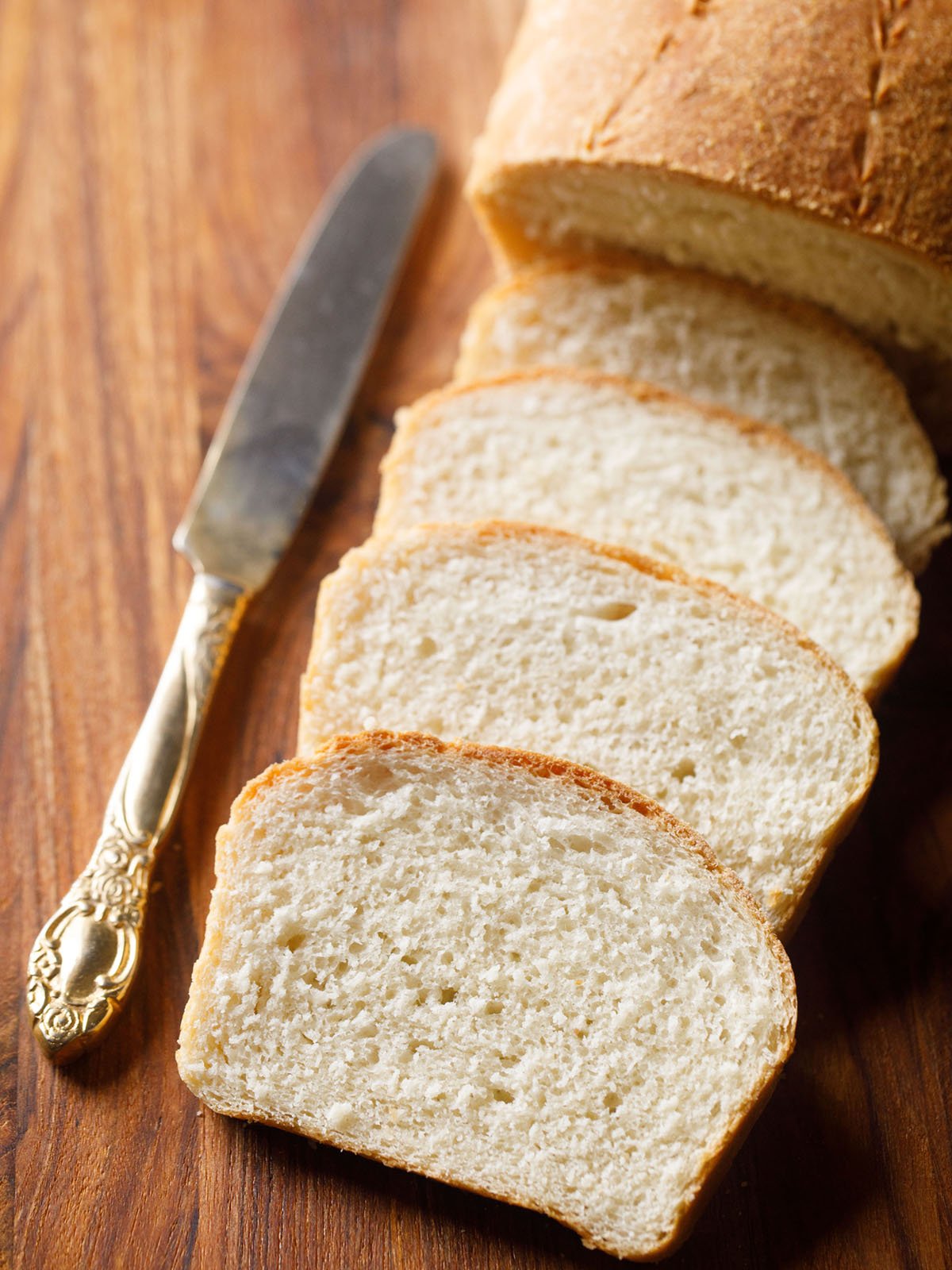
Table of Contents
Why this Bread Recipe Works
I love baking breads at home. The whole process – from making the dough from scratch, kneading with your hands, patiently letting it rise and baking – is terrifically relaxing yet exciting at the same time.
Each loaf is slightly different but brings such joy, both to bake and to eat. And there’s just nothing better than sharing warm, soft slices of homemade bread with your family and friends…Like handing them a piece of your love!
This easy lean bread recipe is great for customizing with additional ingredients. If you want you can add some milk for a softer bread (details in the recipe).
You can also make it into sweet bread by adding extra sugar; or bakes a savory white bread by adding herbs and spices.
Below are steps and photos for making a perfectly fluffy and tender basic loaf of white bread. Give this simple homemade bread recipe a try and you’ll likely fall in love, too.
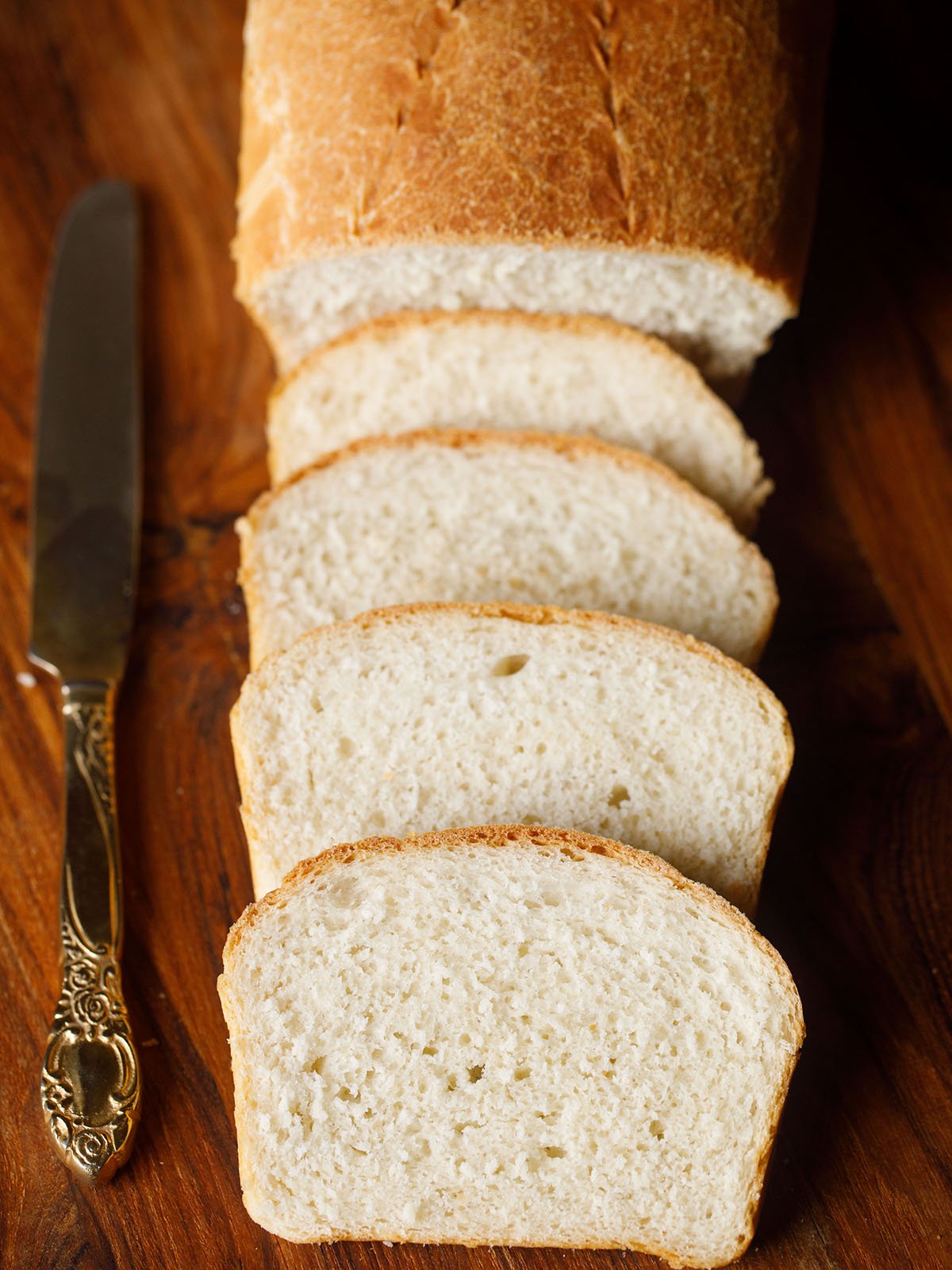
Essential Tips For Any Bread Recipe
While it is a very simple process to make bread from scratch, there are a few key points to keep in mind when you make any bread recipe. You need to follow these pro tips to ensure your loaf is perfect in every way, every time:
- Buy quality ingredients. The best, most delicious bread is made with the best ingredients available. Opt for high-quality flour and yeast, and make sure all ingredients are within the expiration dates. For white breads like these, I recommend unbleached all-purpose flour or bread flour, preferably organic.
- Use warm water. The dry active yeast needs to be treated just rise for the perfect rise. That means it needs to be dissolved in water that is neither hot nor cold but is somewhere in the warm 110-115 degree Fahrenheit (43-46 degrees Celsius). If the water is too cold it won’t activate the yeast, and if it is too hot it will cook the yeast and leave it inactive.
- Kneading: Remember to knead your dough well. If kneading by hand, then spend at-least 10 minutes doing so. The dough has to pass the windowpane test. Take a small portion of the dough and flatten, stretch, spread it into a thin layer. It should not tear or break. You should be able to see through it much like you see through a windowpane.
- Be patient. There will be some periods of resting and waiting while the dough rises and the loaf bakes. Avoid the urge to rush and you will be rewarded with the fluffiest and most tender homemade bread.
- Have fun. Baking bread is all about bringing some warmth and happiness to the house. Bread made with love – or any dishes made with love – simply tastes the best.
See? Simple. Once you perfect the easy, joyful art of baking fresh white bread at home I promise you won’t want store bought loaves again!
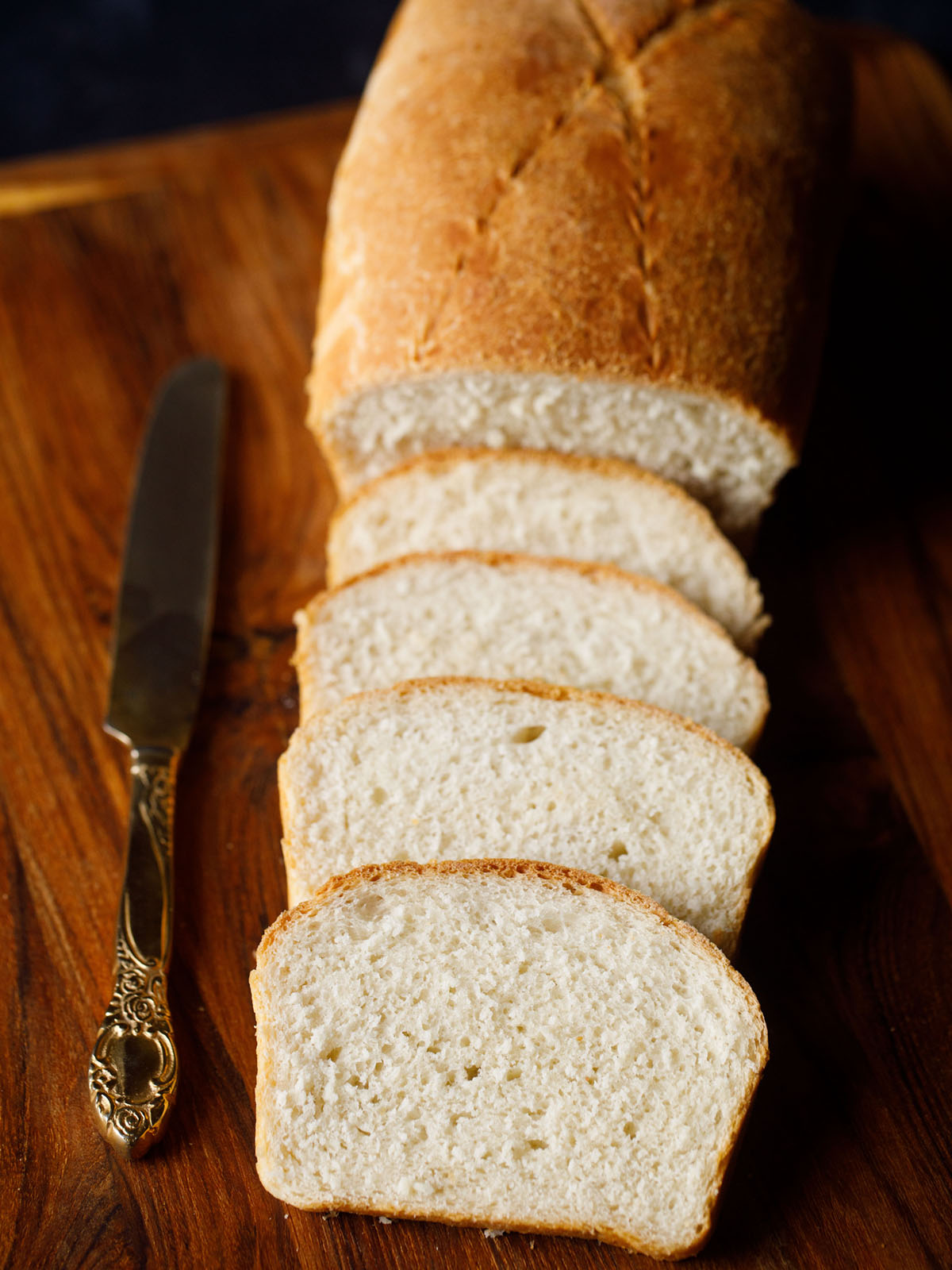
How to make Homemade Bread
Proofing the yeast
1. Take 1 teaspoon instant yeast (rapid rise yeast) or 1.5 teaspoons dry active yeast or 1 tablespoon fresh yeast and 1 tablespoon sugar in a small bowl.
Note: I have used instant yeast which can be directly added to the flour. But I am activating it in warm water just to illustrate to you the method of using dry active yeast or fresh yeast – which always needs to be activated.
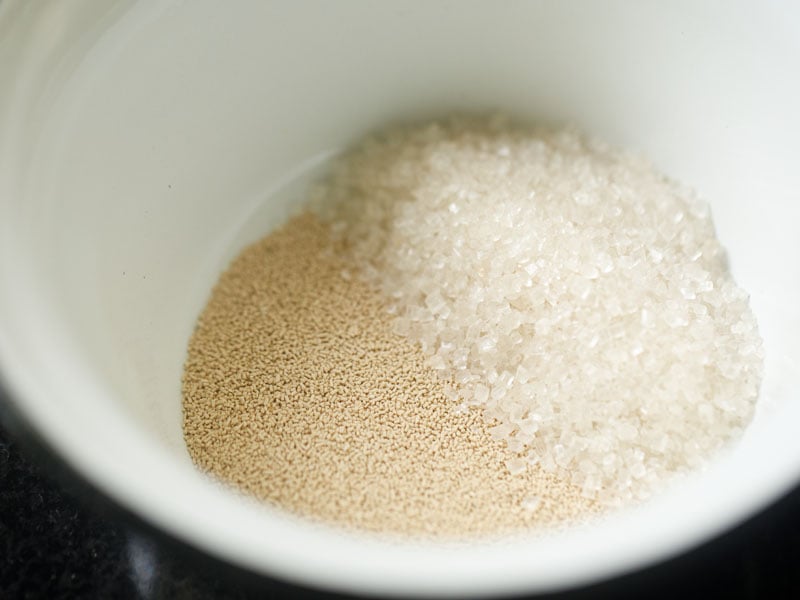
2. Add 1 cup of lukewarm water. Make sure that the water is not hot or cold. The temperature of water should be 41 degrees Celsius (105 to 106 degrees Fahrenheit). Mix it well.
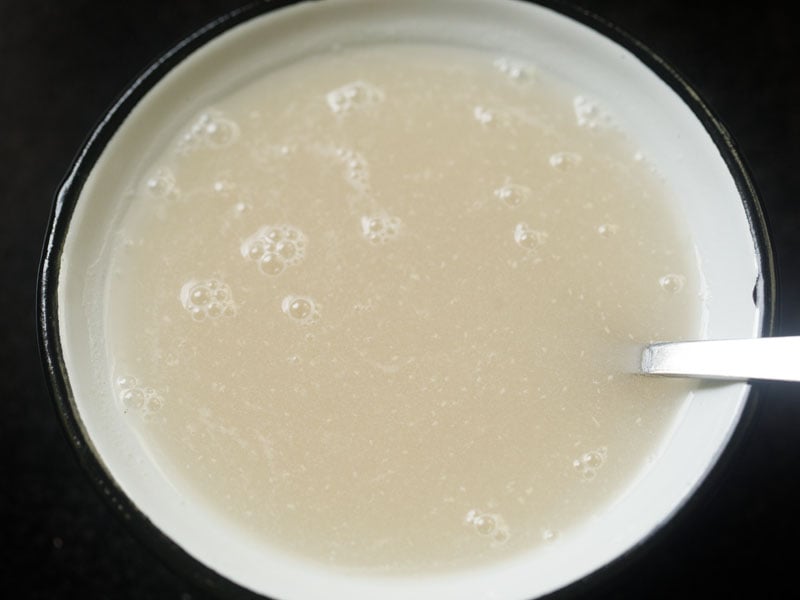
3. Keep in a warm place until the yeast becomes frothy. For instant yeast keep for 5 minutes and for dry active yeast keep for 10 to 15 minutes.
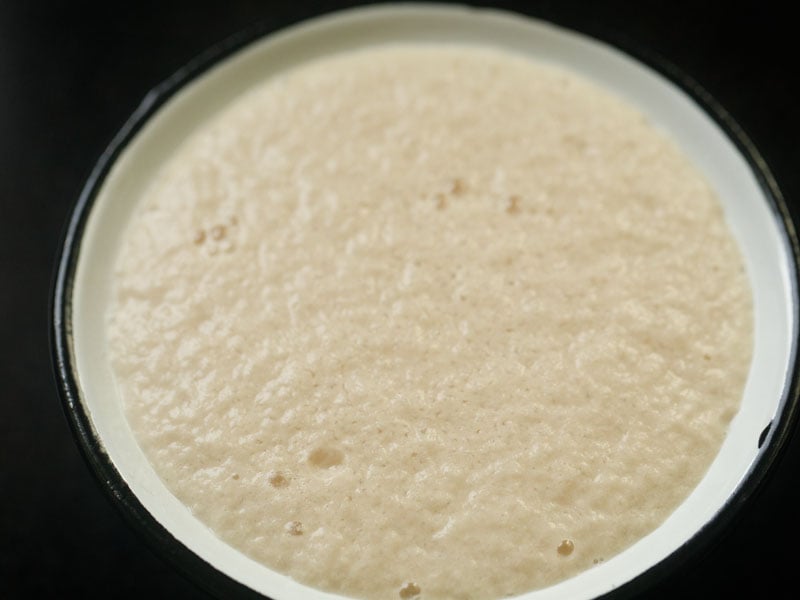
Forming Dough
4. In the meantime take 3 cups of all-purpose flour or bread flour – unbleached or organic (360 grams) and 1 teaspoon salt in a large tray or board or a large bowl. You can also use a stand mixer for kneading dough.
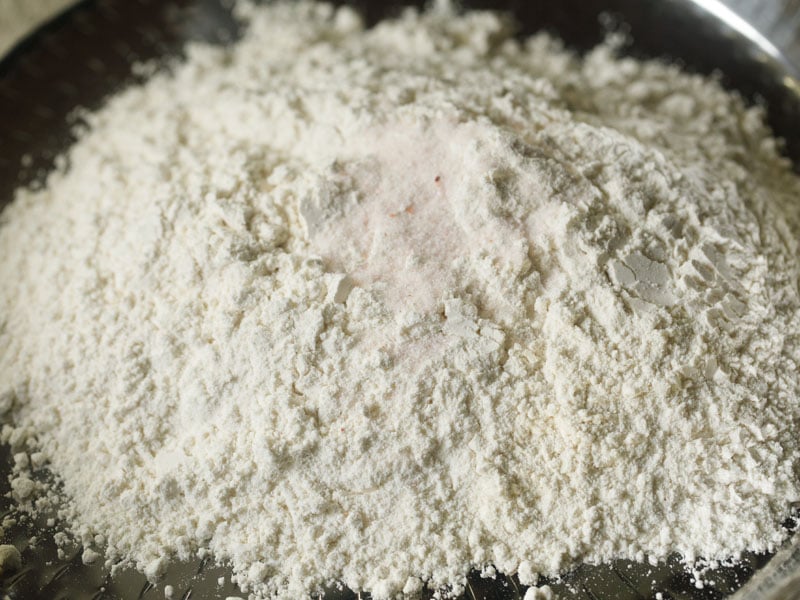
5. Mix well. You can sift the flour with salt if you prefer.
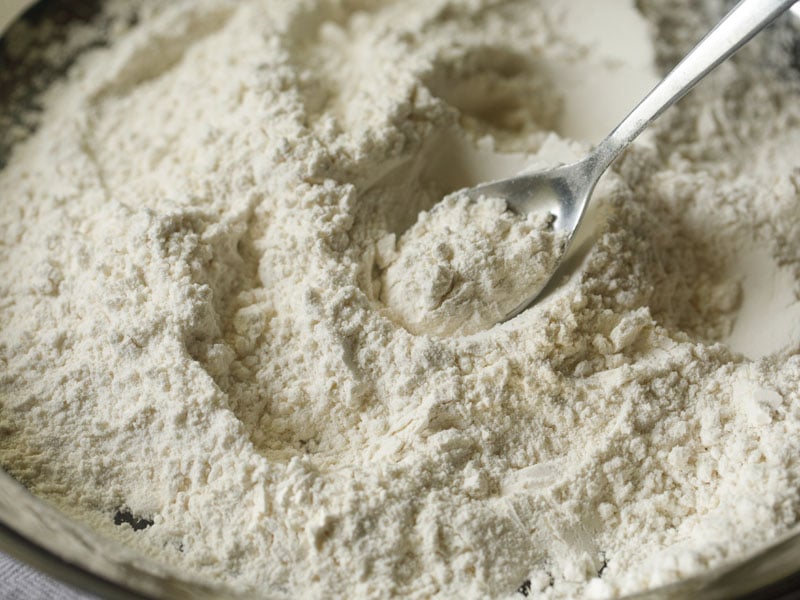
6. Add 1 tablespoon oil – any neutral oil or olive oil. Oil can be swapped for 1 tablespoon butter (dairy or vegan).
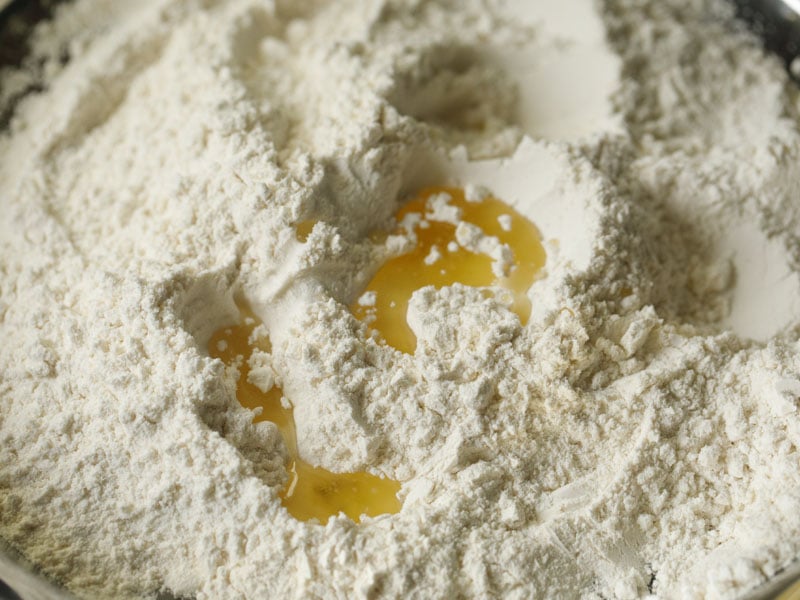
7. Add the frothy bubbly yeast mixture to the flour.
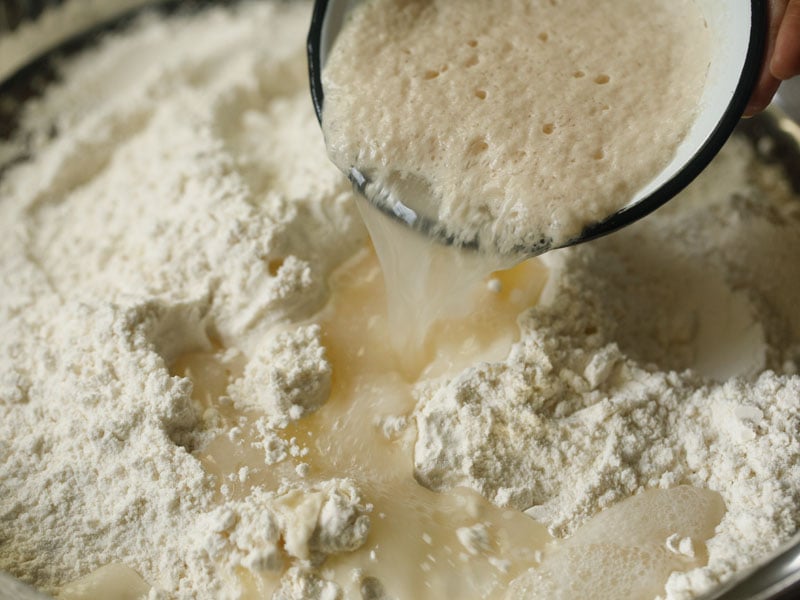
8. Mix with a wooden spoon and you will see that the dough becoming sticky.
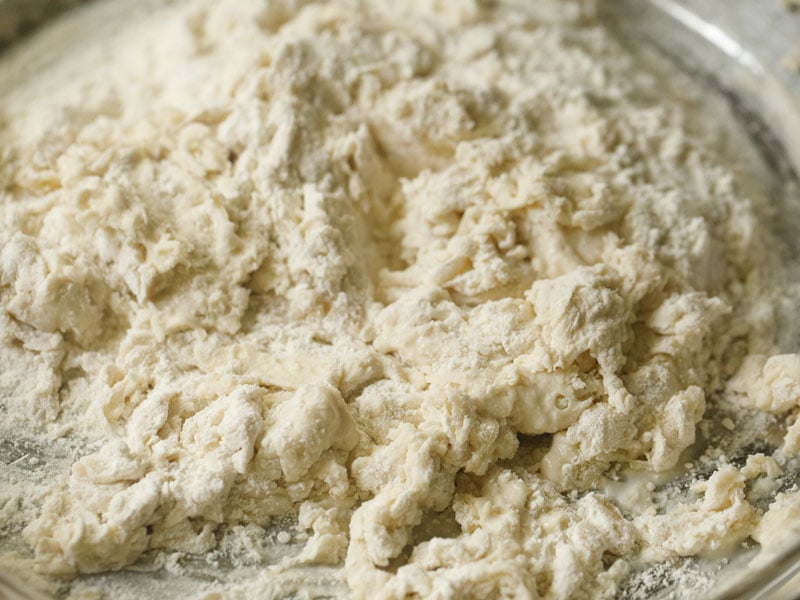
9. Now start kneading the dough for atleast 8 to 10 minutes or until you get a soft smooth, pliable and light consistency.
Tip: If the dough becomes sticky add some flour – mix and knead. If the dough looks floury or dry add a few tablespoons of lukewarm water and knead. Bread flour will need a bit more water than all-purpose flour.
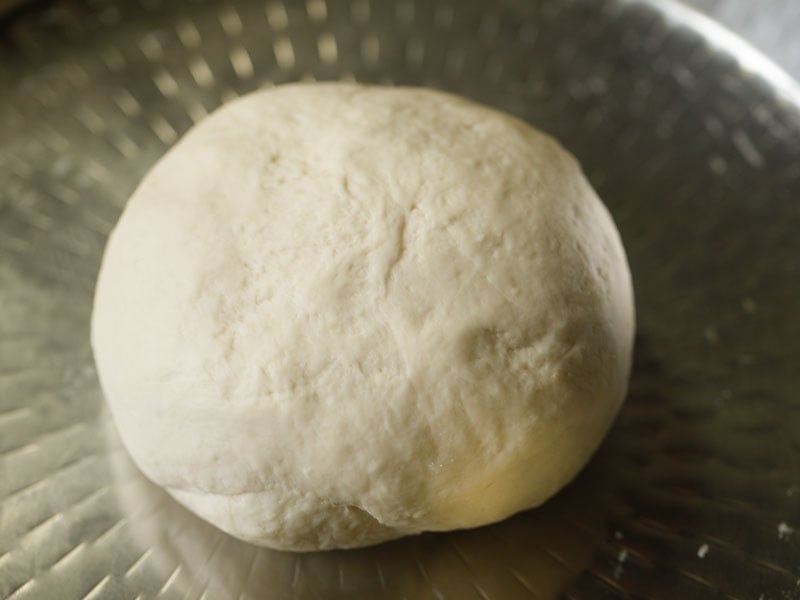
Leavening Dough (First Rise)
10. Cover your bread dough loosely with a large bowl or a kitchen napkin and keep at room temperature to leaven. I used the same plate in which I kneaded the dough. You can brush some oil on the dough prior to leavening it.
- For instant yeast – leaven dough for 45 mins to 1 hour.
- For dry active yeast or fresh yeast– keep for 1.5 to 2 hours.
Tip: A great idea which I follow very often is to leaven the dough using the yogurt settings of your Instant Pot. It works like a charm and so helpful on colder days.
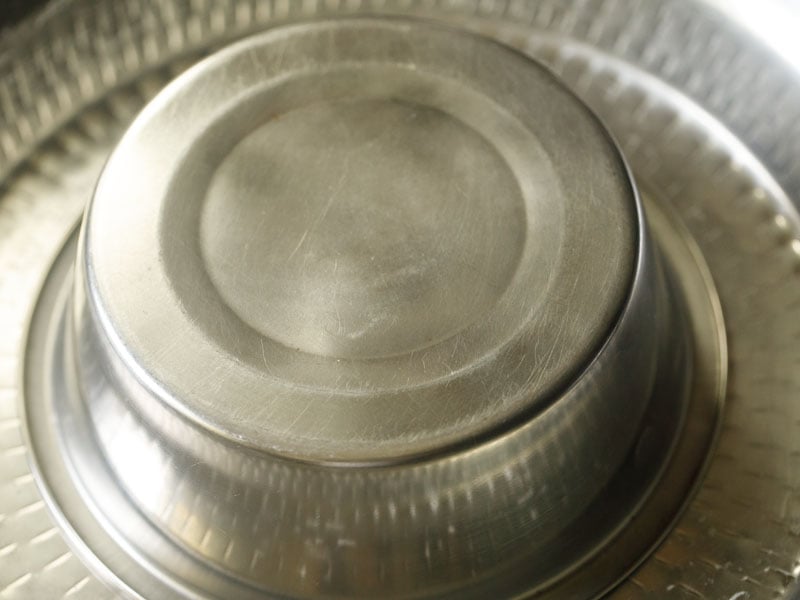
11. After 45 minutes my dough has doubled beautifully.
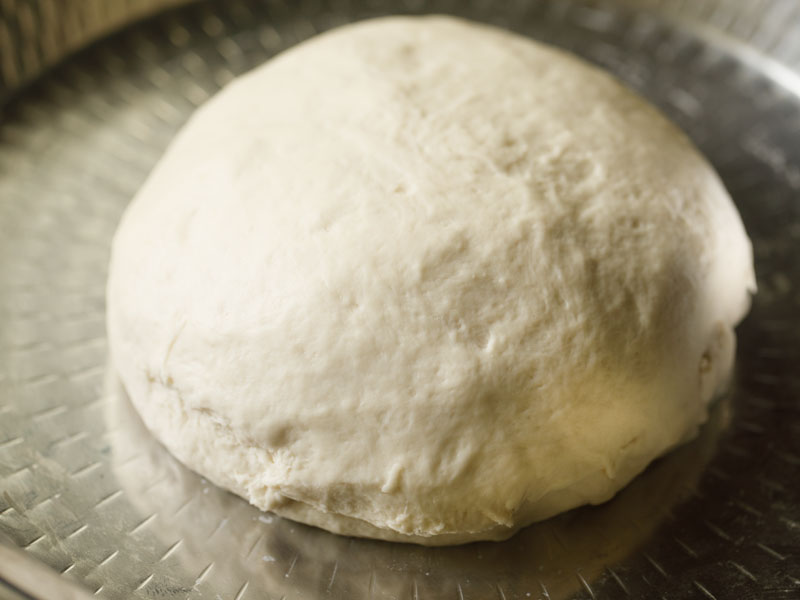
12. Now grease or brush a 9 x 5 inches loaf pan with oil. On a lightly floured surface, lightly knead the dough. This will deflate the dough.
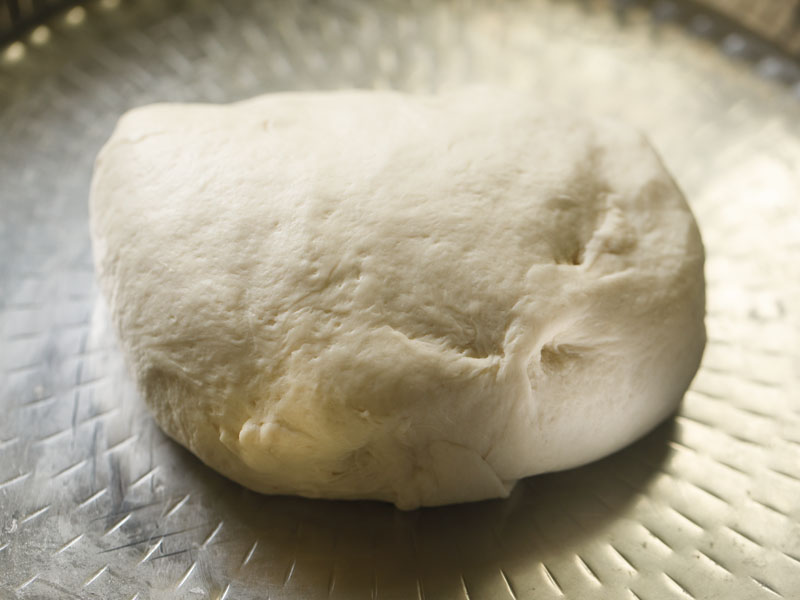
Shaping into a Loaf
13. Flatten the dough with your fingers to a round or square shape. Then begin to roll it.
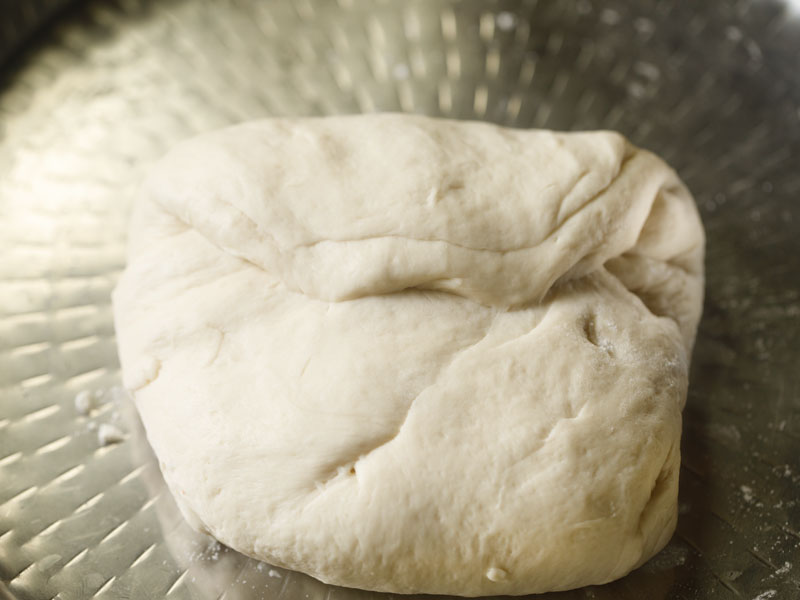
14. Make a neat rolled dough.
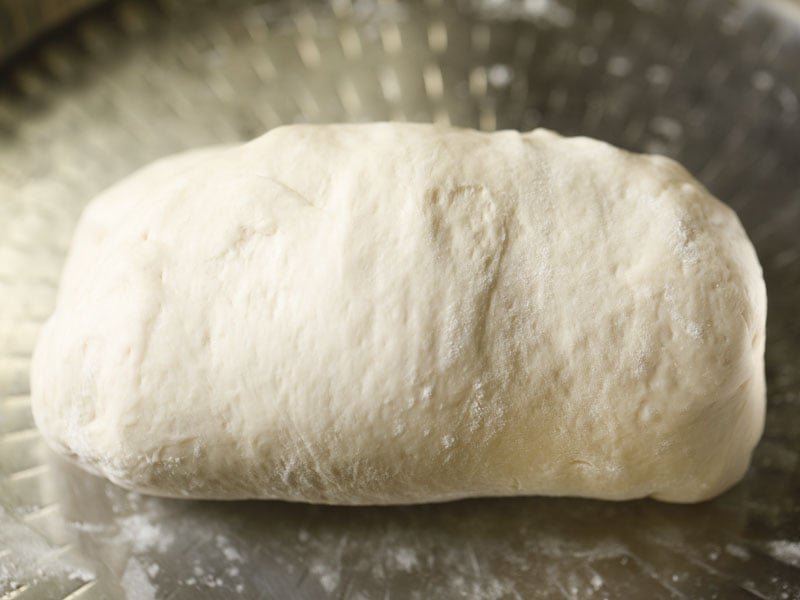
15. The place where the edges meet, join them first. Then press, flatten and smoothen them with your fingers. Smoothen the sides of the loaf as well.
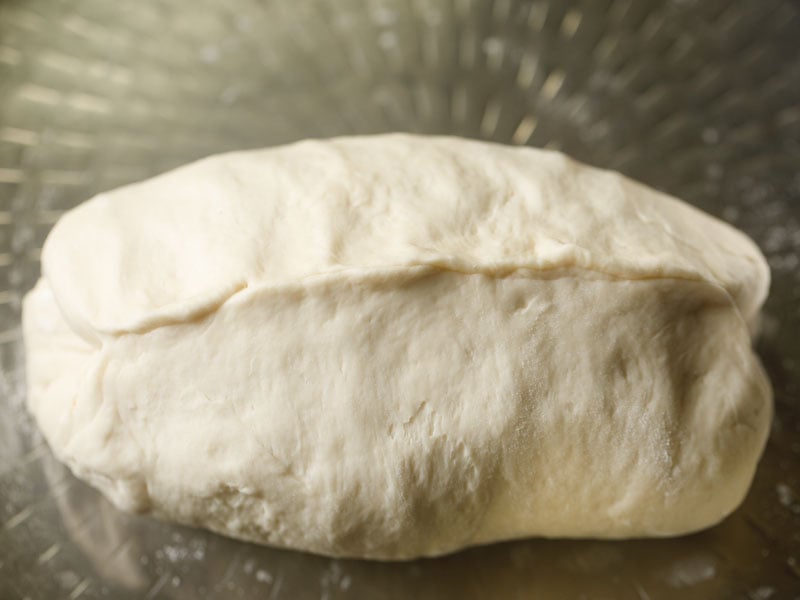
16. Your loaf is ready for the second rise.
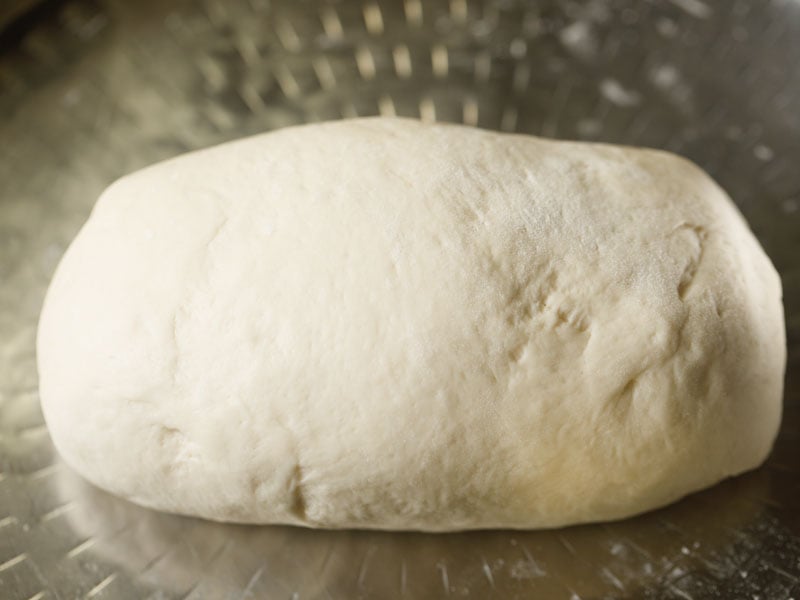
Second Rise
17. Place it in the greased 9 x 5 inches loaf pan with the seamed joined edges touching the bottom of the pan.
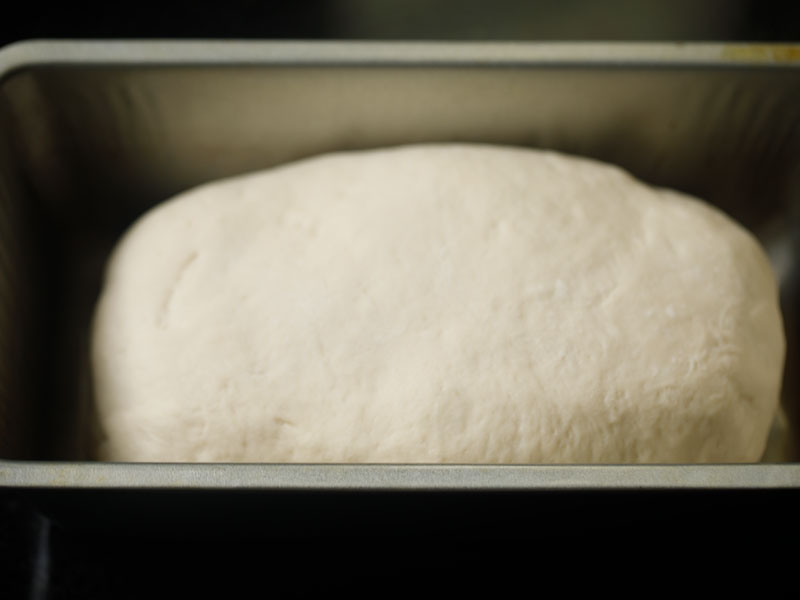
18. Cover the loaf pan with a kitchen towel. Keep it in a warm place.
- If you have used instant yeast – leaven for 20 to 30 minutes.
- For dry active yeast or fresh yeast – set aside for 45 minutes to 1 hour.
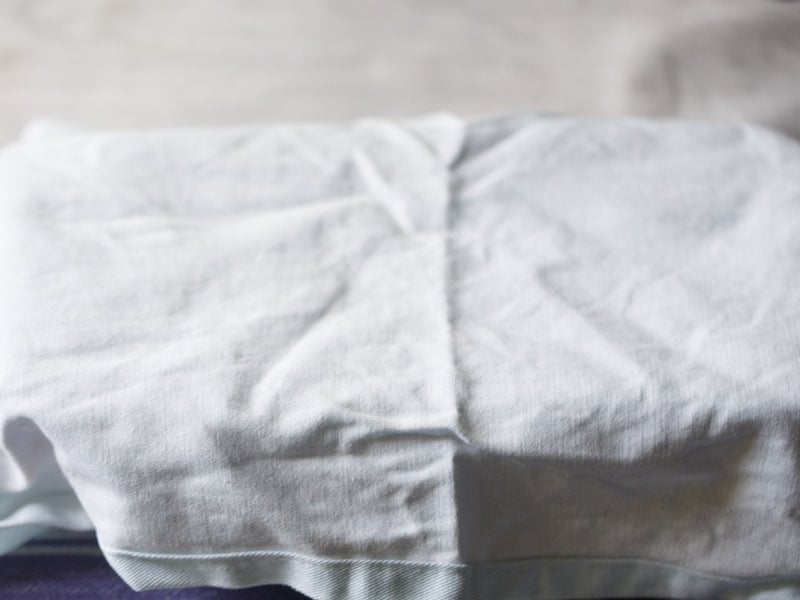
19. The loaf will rise in volume. Remember to preheat your oven 20 minutes prior to baking. Preheat at 190 degrees Celsius (375 degrees Fahrenheit).
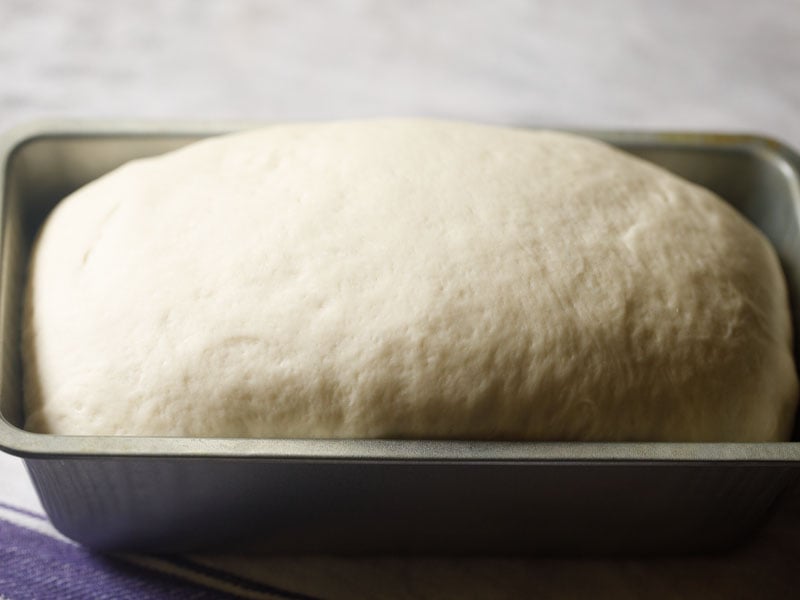
Scoring
20. With a small serrated knife or any sharp knife or a lame, make one long slash or two slashes lengthwise on the center of the dough about ¼ inch deep.
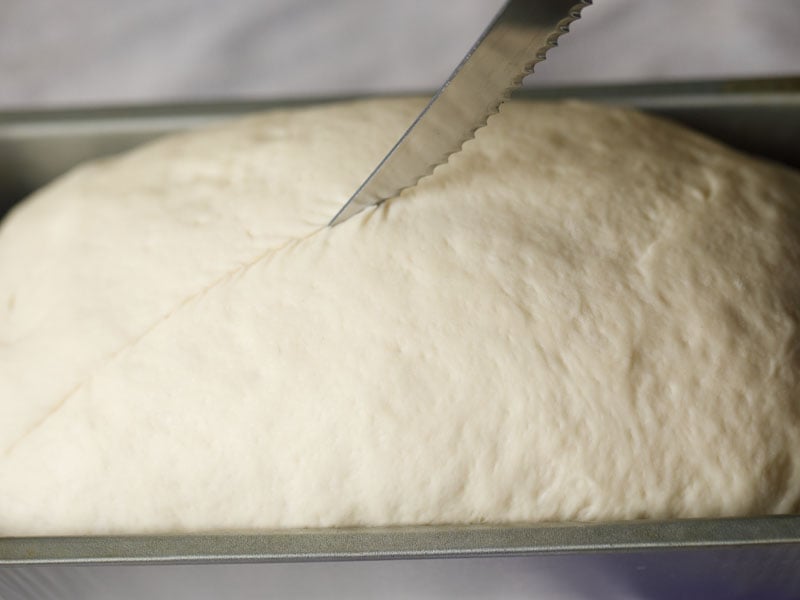
21. Brush the surface with some milk (dairy or vegan). This is an optional step.
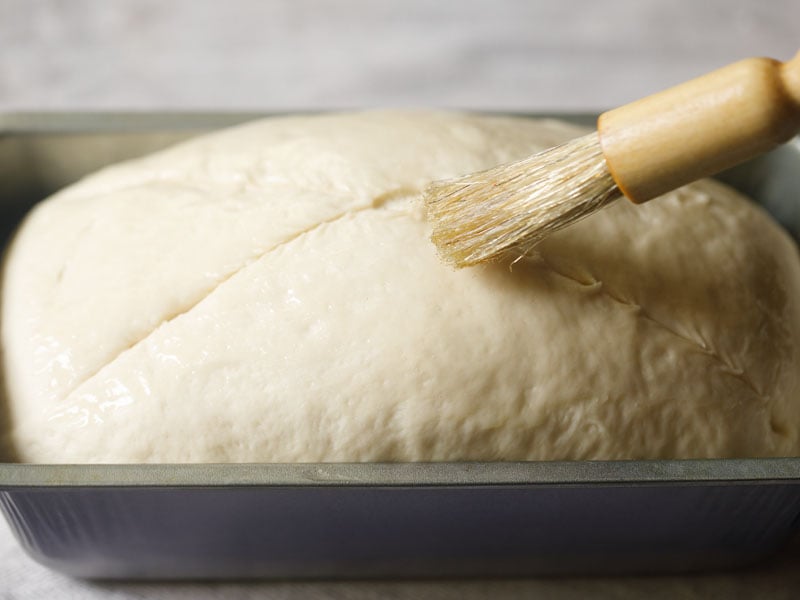
Baking
22. Place the loaf pan in the preheated oven. Bake for 30 to 40 minutes at 190 degrees Celsius (375 degrees Fahrenheit) until the loaf is golden brown. You will also see the sides slightly separated from the pan.
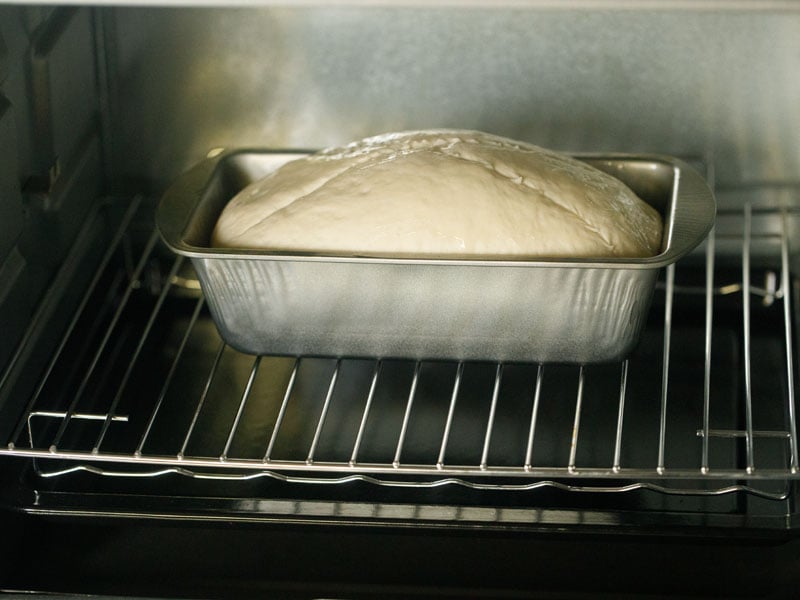
23. In the photo below, you see a lovely loaf of a well baked homemade bread. If your oven browns the surface very quickly, place a parchment paper or aluminium foil on the top of the loaf halfway through the baking – so as to avoid more browning.
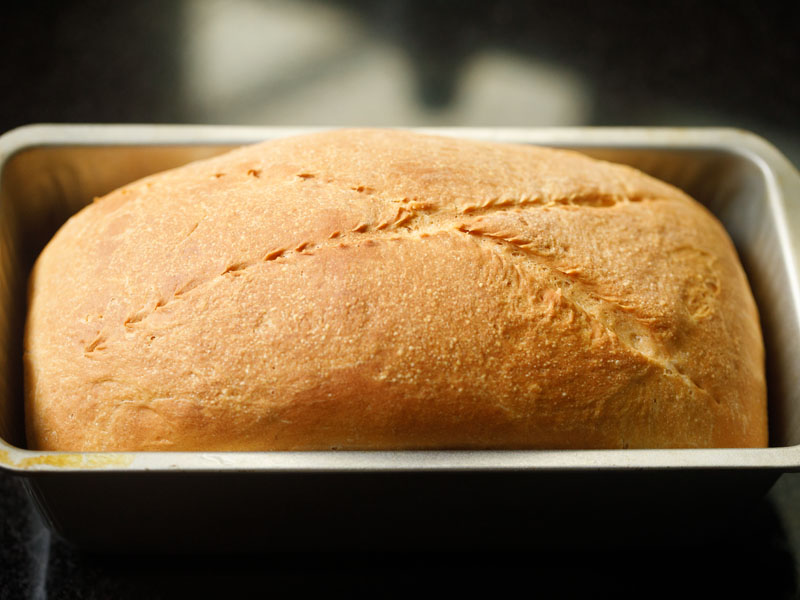
24. Wait for 3 to 4 minutes after the bread is out of the oven. Firstly tap the bread and it should sound hollow – which means that the bread is baked well.
If the bread does not sound hollow, keep it back in the oven to bake for some more minutes.
This is an optional step and you can give it a miss. Remember the bread is hot and so is the pan. Use oven gloves or thick kitchen towels to remove the bread from the pan.
Lift one end of the white bread to check for an even browning at the bottom. If the bottom of the loaf is pale, then keep it directly in the oven (without the pan) for 5 more minutes and bake.
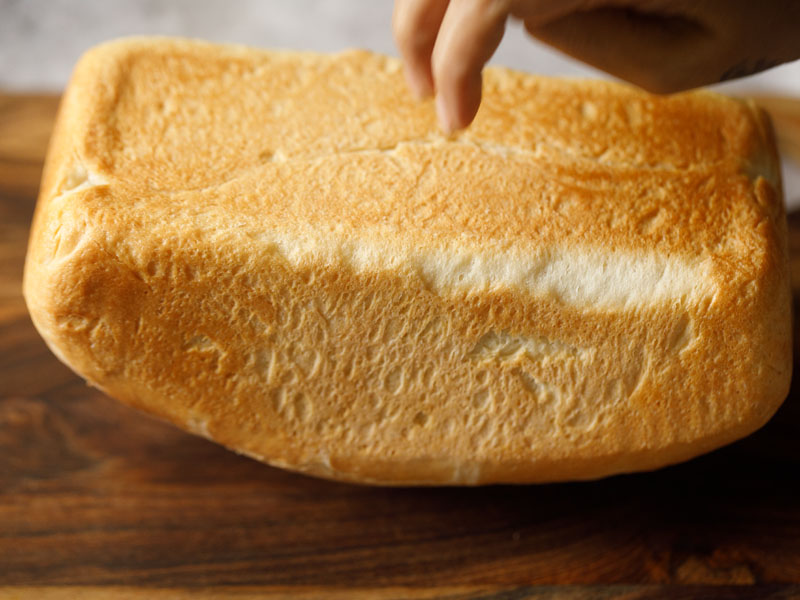
25. Transfer the loaf from the pan immediately and keep it on a wired rack. If you keep it inside the pan, the bottom will get soggy. Let the loaf cool at room temperature on the wired rack or tray.
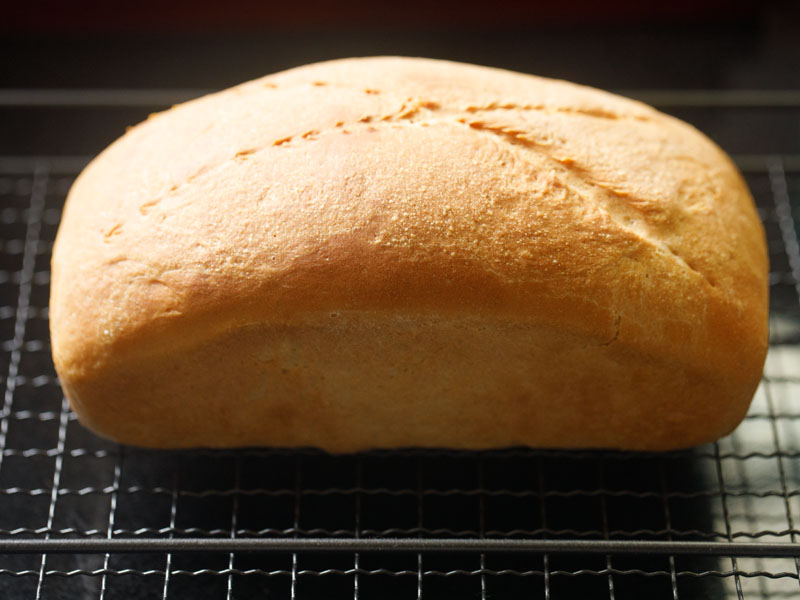
26. Enjoy homemade bread with your favorite curry or soup or just making one of your favorite sandwiches or toast.
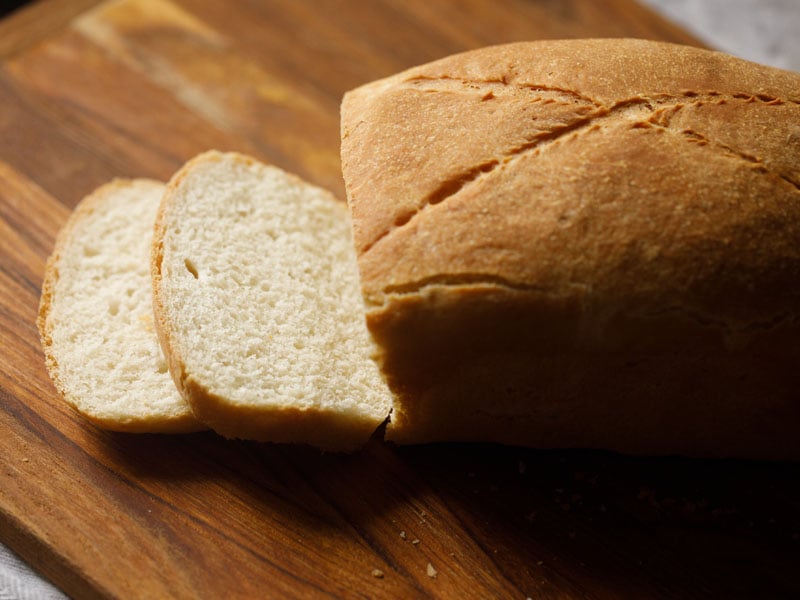
Serving Suggestions
Enjoy slices of warm, freshly baked white bread plain or with a smear of soft butter or lightly toasted in ghee.
Serve toasted bread with jams or topped with slices of avocado, or a tablespoon of peanut butter or preferred nut butter for a yummy snack.
Homemade bread is great for making sandwiches – the only limit is your imagination! Check out my collection of 40 Best Sandwich Recipes for some ideas to get started.
Storage
Place the bread in a bread box or a covered box and refrigerate for a week. At room temperature, it keeps well for 2 to 3 days. You can also freeze it for a couple of months. Thaw before using or defrost it in the refrigerator overnight.
Expert Tips
- Variations: You can divide the dough into parts and make dinner rolls. Add some herbs (fresh or dried) to make a fragrant herb bread. Replace water with milk (dairy or vegan) for a milk bread. Include some more sugar or nuts, berries, dry fruits for a sweet bread.
- Kneading: You can knead the dough with hands as I have done. If you have a food processor or a stand mixer, then knead the dough in these.
- Baking: Since no two ovens are the same, it can take less or more time for the bread to bake in your oven. If the top surface of the bread browns quickly in your oven then place an aluminum foil or parchment paper on the top. This stops the bread from getting browned more.
- Yeast conversion: Make this bread recipe easily with any kind of baking yeast that you have. Follow this yeast conversion: 1 teaspoon instant yeast = 1.5 teaspoon active dry yeast = 1 tablespoon fresh yeast.
- Scalable recipe: Make a large batch of 2 to 3 loaves by easily scaling this recipe.
FAQs
To keep the bread soft I recommend that you store in an airtight bag or a bread box and keep at room temperature for up to 2 to 3 days.
Yes, white bread is great for freezing. Place in an airtight bag or a covered container and store in the freezer for up to 2 to 3 months. Allow the bread to defrost in the refrigerator overnight before enjoying.
Divide the dough into equal parts and bake for individual dinner rolls or Pav.
Substitute all-purpose flour with your favorite gluten free substitute for an easy GF-friendly white bread recipe.
More Bread Recipes You Can Try!
Bread Recipes
Bread Recipes
Bread Recipes
Bread Recipes
Please be sure to rate the recipe in the recipe card or leave a comment below if you have made it. For more vegetarian inspirations, Sign Up for my emails or follow me on Instagram, Youtube, Facebook, Pinterest or Twitter.
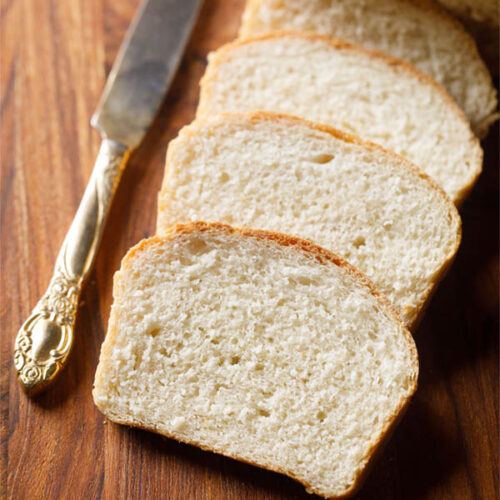
Bread Recipe | White Bread
Ingredients
- 3 cups all-purpose flour or bread flour (preferably unbleached), 360 grams
- 1 cup water (lukewarm)
- 1 teaspoon instant yeast or 1.5 teaspoon dry active yeast or 1 tablespoon fresh yeast
- 1 tablespoon sugar
- 1 tablespoon oil neutral flavored oil or olive oil
- 1 teaspoon salt or add as required
- 1 to 2 tablespoons milk (dairy or vegan) – for brushing, optional
Instructions
Proofing yeast
- In a small bowl take the instant yeast or dry active yeast and sugar. Add lukewarm water.
- Mix well and set aside until the yeast activates. For instant yeast keep for 5 minutes and for dry active yeast keep for 10 to 15 minutes.
Preparing dough
- While the proofing is happening, sieve or mix the flour with salt.
- Add the oil and the frothy yeast mixture to the flour.
- With a wooden spoon mix everything.
- Now use your hands and knead the dough for about 8 to 10 minutes. The dough has to be smooth, soft and light.
- If the dough looks sticky, then add a few tablespoons of flour and knead. If the dough looks dry or floury, add a few tablespoons of lukewarm water and continue to knead.
- Keep in a large bowl and cover loosely with kitchen napkin.
First Rise
- Set aside until the dough doubles up.
- For instant yeast – leaven dough for 45 mins to 1 hour. For dry active yeast or fresh yeast – keep for 1.5 to 2 hours.
- If needed set aside for some more minutes until the dough has doubled up nicely.
Shaping into a loaf
- Grease or brush a 9 x 5 inches loaf pan with oil.
- Take the dough on a lightly floured surface and gently knead. This will deflate the dough.
- Flatten the dough with your fingers to a round or square shape. Then begin to roll it neatly.
- The place where the edges meet, join them first. Then press, flatten and smoothen them with your fingers. Smoothen the sides of the loaf as well.
- Place in the loaf pan with the seamed joined edges touching the bottom of the pan.
Second rise
- Cover again loosely with the kitchen napkin and let it rise again for until fully doubled.
- If you have used instant yeast – leaven for 20 to 30 minutes. For dry active yeast or fresh yeast – set aside for 45 minutes to 1 hour.
- Preheat the oven to 190 degrees Celsius (375 degrees Fahrenheit) for 20 minutes prior to baking.
- With a small serrated knife or any sharp knife or a lame, make one or two long slashes lengthwise on the center of the dough about ¼ inch deep.
- Brush the surface with some milk – dairy or vegan. This is an optional step.
Baking
- Place the loaf pan in the oven. Bake for 30 to 40 minutes at 190 degrees Celsius (375 degrees Fahrenheit) until you see a golden crust.
- If your oven browns the surface very quickly, place a parchment paper or aluminium foil on the top of the loaf halfway through the baking – so as to avoid more browning.
- Wait for 3 to 4 minutes after the bread is out of the oven. Tap the bread and it should sound hollow – which means that the bread is baked well. If the bread does not sound hollow, keep it back in the oven to bake for some more minutes.
- Transfer the loaf from the pan immediately and keep it on a wired rack. If you keep it inside the pan, the bottom gets soggy. Let the loaf cool at room temperature on the wired rack or tray.
- Now enjoy your homemade bread with your favorite curry or soup or just making one of your favorite sandwiches or toast.
Storage
- Place the bread in a bread box or a covered box and refrigerate for a week. Or you can freeze it for a couple of months. Allow the bread to defrost in the refrigerator overnight before serving.
Video
Notes
- Variations: You can divide the dough into parts and make dinner rolls. Add some herbs (fresh or dried) to make a fragrant herb bread. Replace water with milk (dairy or vegan) for a milk bread. Include some more sugar or nuts, berries, dry fruits for a sweet bread.
- Kneading: You can knead the dough with hands as I have done. If you have a food processor or a stand mixer, then knead the dough in these.
- Baking: Since on two ovens are the same, it can take less or more time for the bread to bake in your oven. If the top surface of the bread browns quickly then place an aluminum foil or parchment paper on the top. This will avoid further browning while baking.
- Yeast conversion: Make this bread recipe easily with any kind of baking yeast that you have. Follow this yeast conversion: 1 teaspoon instant yeast = 1.5 teaspoon active dry yeast = 1 tablespoon fresh yeast.
- Scaling: You can halve or double the recipe and make a small or large batch of homemade bread.
Nutrition Info (Approximate Values)
This Bread recipe from the blog archives first published in April 2012 has been updated and republished on April 2023.
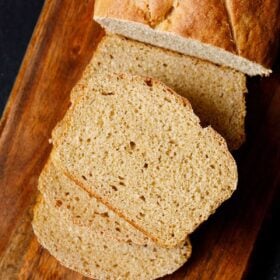
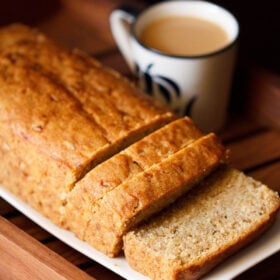
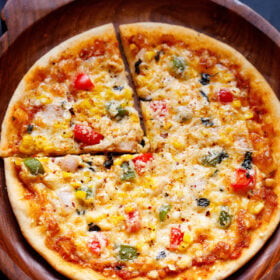
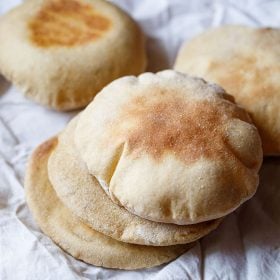








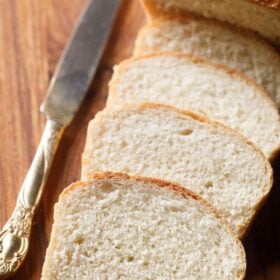
What a wonderful recipe. But actually I am looking for a white bread recipe without yeast. Can you help me out with that please?
till now i have never made any bread without yeast. so i am unable to help you. there are soda breads, beer breads which do not use yeast, but i have never tried them.
I have tried to follow the recipe but when i backed it in microwave oven the end result was not satisfactory. the bread was not presentable
did you use convection baking in microwave. you have not mentioned what went wrong with the bread.
Hi. Just wondering if this has to be done in convection mode since I have many failed attempts in microwave mode.
Ofcourse in the convection mode. This recipe won’t work in microwave mode,
Hi.. loved your recipe.. tried first with maida.. came out great only thing is crust gets very very hard.. can you tell me how to make soft bread like we get in store? also in brown bread I had to cook it longer so crush was ver hard again and bread was very dense.. please tell me proper ratio of yeast and water for 3 cup of whole wheat flour.. and how to make it less dense(I know as for whole wheat it will be dense)
Thanks in advance
hi sapana. let me know which oven you use. regular oven/OTG or the convection mode in microwave. i generally use 1/2 tbsp of dry active yeast for 3 cups of whole wheat flour. check recipe for 100% atta bread on the blog where i have used yogurt to make the bread light & soft.
for the brown bread, depending on the type and quality of flour, you can increase the quantity of water. a slightly moist and wet dough is good and does not make the bread dense while baking. again the yeast must have not proofed well, which might have contributed to the denseness. the yeast should bubble up and cover the whole bowl.
Hi Dassana,
Thanks for replying! I made it in convection mode in microwave. I have added 1/2 tbsp Gloripan yeast in 1 cup of water and not used yogert at all.. I used ashirwad atta 3 cups and added yeast mixture and it was too thick so i have added little milk to make it soft but bread came out very very dense…
Also My biggest problem is hard crush.. When my bread is cooked it very hard to cut through..
Please tell me what temperature I need to cook it and for how long. Also suggest me how to make less dense whole wheat bread.. Yeast I use is fantastic quality.. anything else I can do to make it less dense?
BTW , I tried your pizza recipe.. Its FANTASTIC 🙂 .. Everyone loved it… the pictures u take are tooo goood 🙂
~ sapana
hi sapana. from your description, its looks like the bread was very very dense. i have also made whole wheat bread without adding curd etc. they were dense but not too much. i think its the flour quality. i know gloripan yeast is good. i use the same brand for active yeast. now for the crust, the issue here is both the denseness as well as the baking time. i keep bread loaf at 200 or 220 degrees C and bake for about anywhere between 35 to 60 mins, depending on the recipe and the size of the bread.
since you use convection mode, i suggest you to use -10 to -20 degrees less than what the recipe mentions. since microwave have fans in it. so if the recipe calls for 180 degrees in aregular OTG, you can bake for 170 or 160 degrees C. bread should not be hard to cut through.
whole wheat bread has a denseness. it cannot be as light as the ones made with maida or all purpose flour. the denseness will vary though. if you can get your hands on vital wheat gluten, then it helps to leaven the bread well. then you can also use some yogurt or vinegar. they also help in the gluten development.
i have also seen two methods of making bread which help to make the bread lighter and softer. one is a japanese tangzhong method and the other uses a sponge and biga mixture. you can get more of these methods in books or in other blogs or websites.
Hi! Thanks for your detailed recipe. Luv to try it. Pls tell me if baking has to be fm top and bottom or bottom alone. Eagerly waiting for d response…
when i bake breads at home (which i make every week), i keep the bread in the center rack and both the top as well as the bottom heating elements are on. for this bread however, i used the convection mode in the microwave oven and only the top element is heated.
Can i replace pressure coocker instead of OVEN??
Nirav
breads can be made in the pressure cooker. but i have not tried. so don’t know how this bread recipe would turn out.
Hi Dassana
Wanted to know if we can try this with any other flour. My husband has gluten allergy hence wanted to bake bread at home with other flours such as ragi / rice/ rajgira/ jowar flour.
hi shalu, breads can be made with other flours, but the proportion of the ingredients have to be changed. the whole recipe becomes different. in the market there are gluten free flours available. these are used for making breads and cakes. let me know and i can send you the online links. if you live in india you can buy online. if you live in america then you will be able to get them in the stores.
if you use exclusively ragi or jowar or rajgira, the results are different. i usually combine ragi with wheat flour to make ragi breads. however i have seen that when i increase the proportion of ragi, the bread becomes way too dense.
Can I use baking powder instead of yeast n how much stud I use
you cannot use baking powder.
Turned out perfect!!!! No more bread from the store!
megha, thanks for the positive feedback.
Can v do this in microwave.. and if v can for how minutes should I keep… Thank u.
we can not make this white bread in the microwave
I have tried it but my bread became very hard…
I am not even able to cut it…
Please suggest some thing to avoid it….
the bread become hard as the yeast did not get activated. generally this is the number one reason for bread becoming hard.
Yet another great recipie. Tried this and came out very well in convection itself
thanks shilpa for the feedback and trying out the recipe.
Hi Dassana,
Can this be dough be used to make pizzaz too?
in pizza dough less sugar and a bit more of oil is added. the oil used is olive oil. so the texture is very different from the bread dough. you can check this veg pizza recipe from the blog.
hi dassana,
thanks for this recipe.. i tried it yest and it was really good.. i have posted it in my space too.. do check it out in your free time 🙂
thanks preeti for trying the white bread recipe. i will check on your blog too.
hi Dassana,thanks a lot fr ur white bread recipe.i tried it in microwave ,it cm out vry well.it was soft n all my family members lovd it vry much.all ur recipes are fabulous.i hv tried sm.pls cn u post me th recipe of [atta] brown bread.th expirence of making th bread was great,n th taste n texture was too gud.u just made my day.
Thanks a ton.
thats nice rima. i will post the atta bread soon. bread making is a very satisfactory and lovely task. in fact i make so many breads at home, but just never take pics. there are a few bread recipes in drafts that i will post soon.
Hi Dassana,
My yeast water is not frothing… i bought fresh yeast. What could be the reason
i have never worked with fresh yeast, so cannot pinpoint whats gone wrong.
Hi Dassana,
Sorry to have mislead you, what i meant is dried yeast(but bought new). Since it was not frothing, i went and bought another pack and that did froth. The bread was yummy.
Thanks for the recipe and the many other recipes…. love your blog!
Ida
alright ida. the first packet that you got, the yeast must have deteriorated. hence the frothing did not happen. good to know that finally the bread recipe worked.
Hi Dassana,
My second bread baking trial happened yesterday, and the result was even tastier than the last time 🙂 Thanks!!!!
The top did not brown, but the bottom was the right color and was cooked perfectly. Would glazing the top with some oil before baking help?
thats great. glazing with oil won’t give a golden brown color. but it does help. the top does not dry out or become crusty. you can also brush some milk or beaten eggs. both will give a nice golden brown color on top.
Tried by glazing with milk and got a nice light brown color… and yummy bread. Thanks a bunch!
thanks ida